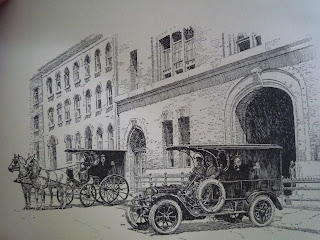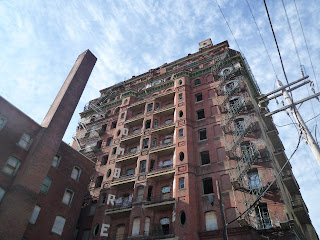If walls could talk, the Naumburg Bandshell would be New York City’s fiercest chatterbox. It’s been standing between Bethesda Terrace and Central Park’s famed, tree-lined Mall Promenade for almost 80 years, collecting memories while sharing music and words.
Visit the Bandshell early in the morning and you’ll find a brief moment of quiet and stillness.
Nauburg Bandshell Photo from Peterjr196's photostream
During the rest of the day, you’ll find actors rehearsing lines, couples posing for wedding photos, shy folks performing dreamy American Idol numbers for empty benches and, of course, every style of music. You might even find an Upper West Side old-timer recalling the bygone era when the Bandshell attracted wayward teenagers from all over the city like a magnet. All throughout the 70s, the Bandshell sheltered a burgeoning graffiti and skateboarding scene along its curved walls, shaded steps, and hidden corners. It was quite a change from the venue’s early days.
The Naumburg Bandshell was erected in 1923, but its purpose had been imagined long before then. A music-lover named Elkan Naumburg had fallen in love with classical music at the age of 15 when he could hardly afford the cost of concert tickets. Forty years later, as a successful banker, he dedicated a large portion of his hard-earned wealth to insure that New Yorkers would always have access to the city’s finest music.
Photo of Elkan Naumburg from ein Treuchtlinger in New York
Naumburg started hosting concerts in Central Park in 1905 on a wood and cast-iron pagoda-like structure that had been created by one of Central Park’s designers, Calvert Vaux. The concerts grew in popularity over the years, drawing crowds from all facets of New York society. The very wealthy would often arrive by carriage and stay there, enjoying performances from their lofty posts above those on foot. When it became more fashionable to walk to concerts, New Yorkers began mingling more freely, strolling along The Mall during performances, picnicking on the grass, and dancing after sunset.
Photo From the New York Public Library Collection
By 1912, free concerts were beginning to attract thousands of New Yorkers. Naumburg offered New York City $125,000 to build a larger, sturdier structure where operas and symphonies could be performed for the growing crowds. In 1923, a year before his death, plans for the Bandshell had been realized as a neo-classic half-dome carved out of Indiana limestone. Ten thousand people attended the dedication where Naumburg drew attention to the words he’d had inscribed on the building: “To the City of New York and its Music Lovers.”
Ever since then, music and spoken word have boomed from that the Bandshell almost without interruption. Irving Berlin, Benny Goodman, and Duke Ellington brought their performed there with their orchestras. Dr. Martin Luther King Jr., E.B. White, and Fidel Castro addressed crowds from its stage. John Lennon’s eulogy was given there, the words carrying toward nearby Bethesda Terrace and Sheep Meadow.
Despite the Bandshell’s longstanding role within New York City’s cultural life, the structure almost faced the wrecking ball in 1992. Once the neo-classical dome became a congregating spot for New York City teens and assorted ‘Parkies’ during the 1970s the location began falling into disrepair. (Check out this SHORT FILM Sunshine Rebels: Gotham's Lost Tribe, about Central Park’s most unique denizens and the Bandshell at its bohemian peak.) By the 1990s, vandals, drug dealers, and homeless New Yorkers had steadily transformed Naumburg’s gift to the city into a building that New York’s Parks and Recreation Department described as “a maintenance nightmare.”
In July of 1993, efforts to tear down the damaged and neglected Bandshell were blocked by the New York State Court of Appeals citing a city law requiring protection of municipal gifts. The building was saved but remained in a state of “demolition by neglect” until 2003 when the Central Park Conservancy and other preservation groups raised more than $2 million to see the structure restored to its former glory. Today, music plays on at the Bandshell thanks to Elkan Naumburg’s descendants and generous support from the public.
Naumburg Bandshell Photo from nycgo.com
Click here to see the complete Naumburg Bandshell schedule of Summer 2012 events.




























